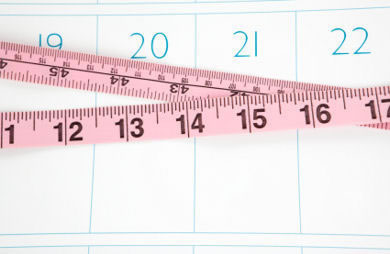Whether you're just breaking onto the workout scene or you're switching things up with a brand new exercise, fitness can sometimes sound like a foreign language. It's already challenging enough to try to feel comfortable in a new environment and master new routines without throwing confusing gym jargon into the mix. Luckily, we've done your homework for you. Below are some of the most common acronyms you may come across in your fitness journey and what they mean.
- AMRAP: This stands for As Many Rounds as Possible (or As Many Reps as Possible), which means completing a series of exercises as many times as you can within the designated time frame. Quality trumps quantity, so five perfect push-ups are better than 10 reps in poor form.
- BMI: Your Body Mass Index is a measurement of where you fall in the range from underweight to obese, based on your height and weight.
- BMR: Your body is always working, even when you're not. Your Basal Metabolic Rate is the number of calories your body uses for basic bodily functions, like breathing, digesting food and pumping your heart.
- BPM: Your heart rate is measured in Beats Per Minute, which indicates the intensity of your workout and how many calories you're burning. You can get this number by taking your pulse or using a heart rate monitor.
- CNS: Together, the brain and spinal cord make up the Central Nervous System, which serves as your body's command center. The CNS manages all of the signals that are sent and received between your brain and body, including while you work out.
- CT: Circuit Training is a type of exercise regimen that alternates heart-pumping cardio intervals with strength (resistance) training, separated by short rest sessions.
- DOMS: If you've ever been sidelined by intense muscle pain a day or two after a workout, you experienced Delayed Onset Muscle Soreness. This is the body's normal, healthy reaction to intense exercise, and isn't cause for concern. (That said, any injury or pain out of the ordinary should be discussed with a doctor.)
- DNF: Almost every runner has started a race with the best of intentions, but then Did Not Finish due to injury, cramping, fatigue or some other sidelining factor.
- DU: When jumping rope, a DU (Double Under) is when you complete two full circuits of the rope before touching your feet back to the ground. Double Dutch, anyone?
- EPOC: As if you needed another reason to work out: Excess Post-Exercise Oxygen Consumption occurs after strenuous exercise, when your body continues taking in more oxygen and burning a higher level of calories. Bonus!
- GPP: Your General Physical Preparedness refers to your overall level of training in fitness fundamentals such as strength, speed, agility and endurance.
- HIIT: High-Intensity Interval Training alternates between high-intensity exercise and longer intervals of low to moderate-intensity exercise. Benefits include a greater calorie burn, more fat-burning potential and reduced muscle loss.
- HRM: A Heart Rate Monitor is a device that gauges how many beats per minute your heart is pumping. Many fitness trackers have built-in heart rate monitors, and other versions use a strap that is worn around the chest. Some cardio machines also have sensors that measure your heart rate.
- LATT: Ever experienced a burning feeling when lifting weights, or pain after a long, hard run? It was most likely due to Lactic Acid Threshold Training, which happens when the level of lactate, also known as lactic acid, rises sharply in the blood. Your body will eventually reabsorb the lactic acid and convert it into energy.
- LISS: Low-Intensity Steady State exercise involves longer periods of exercise at a lower heart rate in the aerobic range, such as walking, hiking and yoga. It's ideal for beginners, those recovering from injury and those returning to fitness after a hiatus.
- MHR: Your highest sustainable heart rate, in beats per minute, is your Maximum Heart Rate. If you're striving to reach the 70 to 85 percent heart rate zone, subtract your age from 220 to calculate your MHR.
- MISS: In the middle ground between HIIT and LISS is MISS, or Moderate Intensity Steady State. This type of medium-intensity cardio will keep you at right around 60 to 80 percent of your MHR.
- MMC: Studies have shown that making a mind-muscle connection—focusing your mental energy on each individual muscle—can actually boost the effectiveness of workouts.
- NEAT: You may be burning more calories than you think. Non-Exercise Activity Thermogenesis includes the calories burned in everyday activities like running errands, cleaning and showering. The combination of your NEAT, your BMR and the thermic effect of the food you eat determines your daily energy requirement.
- PR: This stands for Personal Record, and is used (in either a verb or noun form) when you beat your best in whatever activity you're pursuing, whether it's a 5K finish time, a bench press weight or some other measure of success.
- ROM: Your Range of Motion is the length of movement covered in any given exercise. For instance, if you're doing a squat, you would try to get as low as possible (without sacrificing form) for the maximum range of motion.
- RPE: The Rate of Perceived Exertion is a general scale that measures how intensely you're working during exercise, from 1 to 10. For example, you might rate a leisurely yoga session at a 2, while a grueling spin class might be considered a 9.
- SPP: Specific Physical Preparedness refers to your ability to perform a particular sport or activity. For instance, your SPP for soccer would focus on skills like speed and agility, while hiking may include strength and endurance.
- TDEE: Your Total Daily Energy Expenditure is the cumulative amount of calories burned in any given day. This sum amount includes exercise, regular daily physical activity and basic bodily functions.
- TUT: The Time Under Tension is the length of time your muscle is being worked. Slower, more controlled reps will have a longer TUT than quicker reps.
- WOD: This stands for Workout of the Day, typically used in CrossFit sessions.













